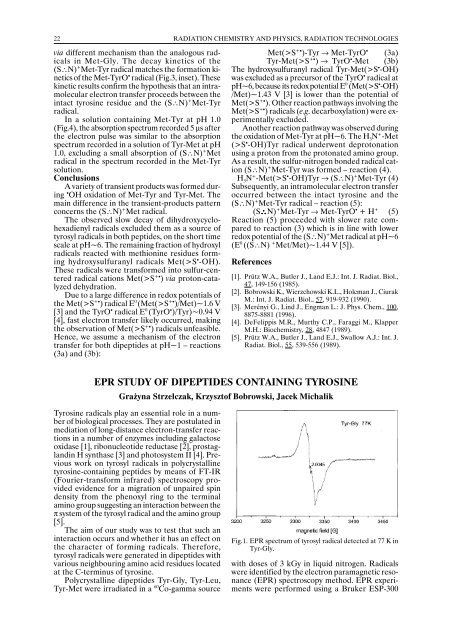annual report annual report annual report annual report 2005
annual report annual report annual report annual report 2005
annual report annual report annual report annual report 2005
Create successful ePaper yourself
Turn your PDF publications into a flip-book with our unique Google optimized e-Paper software.
22<br />
RADIATION CHEMISTRY AND PHYSICS, RADIATION TECHNOLOGIES<br />
via different mechanism than the analogous radicals<br />
in Met-Gly. The decay kinetics of the<br />
(S∴N) + Met-Tyr radical matches the formation kinetics<br />
of the Met-TyrO • radical (Fig.3, inset). These<br />
kinetic results confirm the hypothesis that an intramolecular<br />
electron transfer proceeds between the<br />
intact tyrosine residue and the (S∴N) + Met-Tyr<br />
radical.<br />
In a solution containing Met-Tyr at pH 1.0<br />
(Fig.4), the absorption spectrum recorded 5 µs after<br />
the electron pulse was similar to the absorption<br />
spectrum recorded in a solution of Tyr-Met at pH<br />
1.0, excluding a small absorption of (S∴N) + Met<br />
radical in the spectrum recorded in the Met-Tyr<br />
solution.<br />
Conclusions<br />
A variety of transient products was formed during<br />
• OH oxidation of Met-Tyr and Tyr-Met. The<br />
main difference in the transient-products pattern<br />
concerns the (S∴N) + Met radical.<br />
The observed slow decay of dihydroxycyclohexadienyl<br />
radicals excluded them as a source of<br />
tyrosyl radicals in both peptides, on the short time<br />
scale at pH~6. The remaining fraction of hydroxyl<br />
radicals reacted with methionine residues forming<br />
hydroxysulfuranyl radicals Met(>S • -OH).<br />
These radicals were transformed into sulfur-centered<br />
radical cations Met(>S +• ) via proton-catalyzed<br />
dehydration.<br />
Due to a large difference in redox potentials of<br />
the Met(>S +• ) radical E 0 (Met(>S +• )/Met)~1.6 V<br />
[3] and the TyrO • radical E 0 (TyrO • )/Tyr)~0.94 V<br />
[4], fast electron transfer likely occurred, making<br />
the observation of Met(>S +• ) radicals unfeasible.<br />
Hence, we assume a mechanism of the electron<br />
transfer for both dipeptides at pH~1 – reactions<br />
(3a) and (3b):<br />
Met(>S +• )-Tyr → Met-TyrO • (3a)<br />
Tyr-Met(>S +• ) → TyrO • -Met (3b)<br />
The hydroxysulfuranyl radical Tyr-Met(>S • -OH)<br />
was excluded as a precursor of the TyrO • radical at<br />
pH~6, because its redox potential E 0 (Met(>S • -OH)<br />
/Met)~1.43 V [3] is lower than the potential of<br />
Met(>S +• ). Other reaction pathways involving the<br />
Met(>S +• ) radicals (e.g. decarboxylation) were experimentally<br />
excluded.<br />
Another reaction pathway was observed during<br />
the oxidation of Met-Tyr at pH~6. The H 3<br />
N + -Met<br />
(>S • -OH)Tyr radical underwent deprotonation<br />
using a proton from the protonated amino group.<br />
As a result, the sulfur-nitrogen bonded radical cation<br />
(S∴N) + Met-Tyr was formed – reaction (4).<br />
H 3 N + -Met(>S • -OH)Tyr → (S∴N) + Met-Tyr (4)<br />
Subsequently, an intramolecular electron transfer<br />
occurred between the intact tyrosine and the<br />
(S∴N) + Met-Tyr radical – reaction (5):<br />
(S∴N) + Met-Tyr → Met-TyrO • + H + (5)<br />
Reaction (5) proceeded with slower rate compared<br />
to reaction (3) which is in line with lower<br />
redox potential of the (S∴N) + Met radical at pH~6<br />
(E 0 ((S∴N) + Met/Met)~1.44 V [5]).<br />
References<br />
[1]. Prütz W.A., Butler J., Land E.J.: Int. J. Radiat. Biol.,<br />
47, 149-156 (1985).<br />
[2]. Bobrowski K., Wierzchowski K.L., Holcman J., Ciurak<br />
M.: Int. J. Radiat. Biol., 57, 919-932 (1990).<br />
[3]. Merényi G., Lind J., Engman L.: J. Phys. Chem., 100,<br />
8875-8881 (1996).<br />
[4]. DeFelippis M.R., Murthy C.P., Faraggi M., Klapper<br />
M.H.: Biochemistry, 28, 4847 (1989).<br />
[5]. Prütz W.A., Butler J., Land E.J., Swallow A.J.: Int. J.<br />
Radiat. Biol., 55, 539-556 (1989).<br />
EPR STUDY OF DIPEPTIDES CONTAINING TYROSINE<br />
Grażyna Strzelczak, Krzysztof Bobrowski, Jacek Michalik<br />
Tyrosine radicals play an essential role in a number<br />
of biological processes. They are postulated in<br />
mediation of long-distance electron-transfer reactions<br />
in a number of enzymes including galactose<br />
oxidase [1], ribonucleotide reductase [2], prostaglandin<br />
H synthase [3] and photosystem II [4]. Previous<br />
work on tyrosyl radicals in polycrystalline<br />
tyrosine-containing peptides by means of FT-IR<br />
(Fourier-transform infrared) spectroscopy provided<br />
evidence for a migration of unpaired spin<br />
density from the phenoxyl ring to the terminal<br />
amino group suggesting an interaction between the<br />
π system of the tyrosyl radical and the amino group<br />
[5].<br />
The aim of our study was to test that such an<br />
interaction occurs and whether it has an effect on<br />
the character of forming radicals. Therefore,<br />
tyrosyl radicals were generated in dipeptides with<br />
various neighbouring amino acid residues located<br />
at the C-terminus of tyrosine.<br />
Polycrystalline dipeptides Tyr-Gly, Tyr-Leu,<br />
Tyr-Met were irradiated in a 60 Co-gamma source<br />
Fig.1. EPR spectrum of tyrosyl radical detected at 77 K in<br />
Tyr-Gly.<br />
with doses of 3 kGy in liquid nitrogen. Radicals<br />
were identified by the electron paramagnetic resonance<br />
(EPR) spectroscopy method. EPR experiments<br />
were performed using a Bruker ESP-300
















